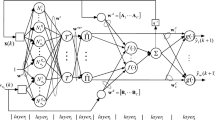Abstract
This paper investigates the model predictive stabilization problem for Takagi–Sugeno (T–S) fuzzy multilayer neural networks with general terminal weighting matrix. A new set of linear matrix inequality (LMI) conditions on the general terminal weighting matrix of receding horizon cost function is presented such that T–S fuzzy multilayer neural networks with model predictive stabilizer are asymptotically stable. The general terminal weighting matrix of receding horizon cost function can be obtained by solving a set of LMIs. A numerical example is given to illustrate the effectiveness of the proposed stabilization scheme.


Similar content being viewed by others
References
Hopfield J (1984) Neurons with grade response have collective computational properties like those of two-state neurons. Proc Natl Acad Sci 81:3088–3092
Gupta MM, Jin L, Homma N (2003) Static and dynamic neural networks. Wiley-Interscience, London
Takagi T, M Sugeno (1985) Fuzzy identification of systems and its applications to modeling and control. IEEE Trans Syst Man Cybern 15:116–132
Tanaka K, Sugeno M (1992) Stability analysis and design of fuzzy control systems. Fuzzy Sets Syst 45:135–156
Huang H, Ho D, Lam J (2005) Stochastic stability analysis of fuzzy Hopfield neural networks with time-varying delays. IEEE Trans Circ Syst II 52:251–255
Ali M, Balasubramaniam P (2009) Stability analysis of uncertain fuzzy Hopfield neural networks with time delays. Commun. Nonlinear Sci Numer Simul 14:2776–2783
Li H, Chen B, Zhou Q, Qian W (2009) Robust stability for uncertain delayed fuzzy Hopfield neural networks with markovian jumping parameters. IEEE Trans Syst Man Cybern B 39:94–102
Ahn CK (2010) Delay-dependent state estimation for T–S fuzzy delayed Hopfield neural networks. Nonlinear Dyn 61(3):483–489
Ahn CK (2011) Some new results on stability of Takagi–Sugeno fuzzy Hopfield neural networks. Fuzzy Sets and Syst 179(1):100–111
Ahn CK (2011) Takagi–Sugeno fuzzy Hopfield neural networks for \(\mathcal{H}_\infty\) nonlinear system identification. Neural Processing Lett 34(1):59–70
Ahn CK (2011) \(\mathcal{H}_\infty\) state estimation for Takagi–Sugeno fuzzy delayed Hopfield neural networks. Int J Comput Intell Syst 4(5):855–862
Ahn CK (2012) Exponential \(\mathcal{H}_\infty\) stable learning method for Takagi–Sugeno fuzzy delayed neural networks: a convex optimization approach. Comput Math Appl 64(5):887–895
Ahn CK, Song MK (2013) New sets of criteria for exponential \(\mathcal{L}_2-\mathcal{L}_\infty\) stability of Takagi–Sugeno fuzzy systems combined with Hopfield neural networks. Int J Innov Comput Inf Control (in press)
Kwon WH, Pearson AE (1977) A modified quadratic cost problem and feedback stabilization of a linear system. IEEE Trans Autom Control 22:838–842
Kwon WH, Pearson AE (1978) On feedback stabilization of time-varying discrete linear systems. IEEE Trans Autom Control 23:479–481
Keerthi SS, Gilbert EG (1988) Optimal infinite horizon feedback laws for a general class of constrained discrete-time systems: stability and moving-horizon approximation. J Optim Theory Appl 57:265–293
Kothare MV, Balakrishnan V, Morari M (1996) Robust constrained model predictive control using linear matrix inequalities. Automatica 32:1361–1379
Chen H, Allgower F (1998) A quasi-infinite horizon nonlinear model predictive control scheme with guaranteed stability. Automatica 34:1205–1217
Kwon WH, Kim KB (2000) On stabilizing receding horizon controls for linear continuous time-invariant systems. IEEE Trans Autom Control 45:1329–1334
Boyd S, Ghaoui LE, Feron E, Balakrishinan V (1994) Linear matrix inequalities in systems and control theory. SIAM, Philadelphia, PA
Ahn CK (2013) Takagi–Sugeno fuzzy receding horizon \(\mathcal{H}_\infty\) chaotic synchronization and its application to Lorenz system. Nonlinear Anal Hybrid Syst 9:1–8
Author information
Authors and Affiliations
Corresponding author
Rights and permissions
About this article
Cite this article
Ahn, C.K., Lim, M.T. Model predictive stabilizer for T–S fuzzy recurrent multilayer neural network models with general terminal weighting matrix. Neural Comput & Applic 23 (Suppl 1), 271–277 (2013). https://doi.org/10.1007/s00521-013-1381-3
Received:
Accepted:
Published:
Issue Date:
DOI: https://doi.org/10.1007/s00521-013-1381-3




